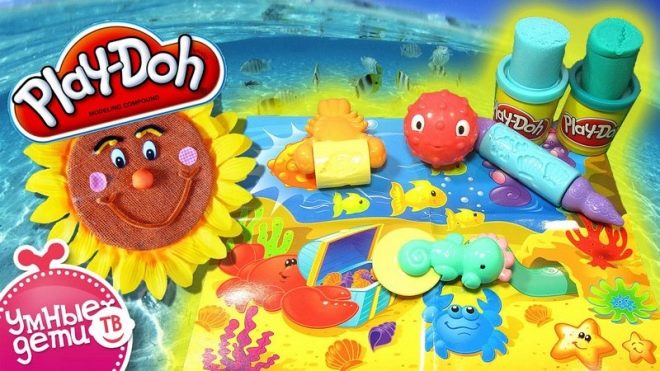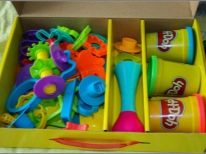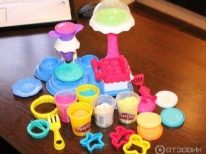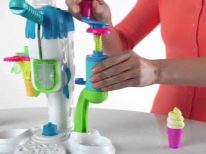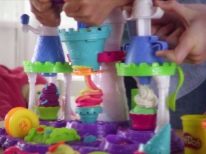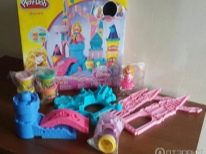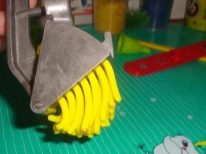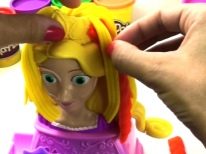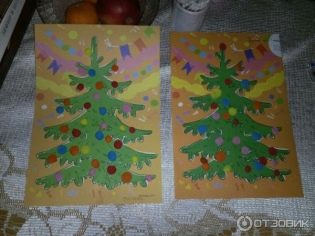What blind from the Play-Doh?
Sculpting - one of the most useful developmental exercises for a child in preschool and primary school age. Despite the fact that today a good dozen of different masses were invented for modeling, plasticine remains the most relevant one. In its composition, it differs for the better from that to which many of us have become accustomed in the distant childhood. Among the large assortment of modern trademarks presented for sale, Play Doh is particularly popular: this material completely safe for baby due to its 100% natural composition, it attracts kids with a bright look.
Balls and sausages
When a child mashes the mass abstractly, there will be no outstanding result from this: this task is not too difficult to develop sufficiently and not too interesting to stimulate enthusiasm and push it to enter new levels. That is why adults engaged in molding with a child should have an idea of what crafts can be molded from clay of this type.
To the child was always interesting, the tasks assigned to him must correspond to his current level of development.
The very first and simple exercise for a child who has just begun to learn modeling is banal skating of primitive figures. Someone fears that such an occupation does not seem interesting to a small child. However, at the age of 2-4 years old, when the middle child begins to be interested in this, he perceives this in the form of a game (especially if the parents have tried to choose a lot of bright enough colors).
Although this occupation for adults seems to be quite simple, in fact, for this age, it has a pronounced developmental function. Firstly, the child knows the world: it reveals that it can influence the shape and size of some surrounding objects. Surely fine hand motor skills are improvedwhich in children of this age is still underdeveloped.
Slightly diversifying the set of figures with cubes and triangles, you can try to gradually learn with the child the names of geometric shapes, as well as the names of colors. The kid can be offered to count the figures he molded, which will consolidate his first mathematical skills. Riding balls and sausages is the first, starting step in the process of teaching serious modeling, since most of the impressively beautiful handicrafts actually also consist of such simple shapes.
Ready sets
After mastering simple child figurines, you need to take some more complex and interesting things, otherwise he will quickly lose interest in the lesson. He himself is still not ready to make truly artistic crafts. At this moment, sets of plasticine and various molds produced by the manufacturer Play Doh come to the rescue, designed to simplify the molding process to the utmost.
Awesome bonus is large variety of sets: at least one of them will correspond to the interests of the baby.
A typical set consists of the very plastic mass of the required shades (it’s usually not a full-color set), as well as special tools that do not help to make anything, but are ideally suited for sculpting a particular craft.
A simple example is the ice cream set, which includes a plastic horn and a special press for squeezing clay. Filling the press with colored clay in any order, the child can create very natural ice cream.Unlike fully handicrafts, the result will be really similar.
In more expensive sets, it is often possible to find completely plastic additions, while clay performs only a specific decorative function. For example, plastic Disney princesses can be included in the package, which can be used to create dresses with a special shape.
Such plasticine clothing can be made mechanically in several varieties at once. Girls will especially like it, because every time you can again choose what color the outfit will be. In the most expensive sets of "Play Do" they sell entire city streets, in which you can find a house, tower clock, fire stations, shops and much more.
Experiments with improvised means
If the child’s interest in sculpting has not disappeared (or has been re-warmed up with the help of kits) after simple shapes have been mastered, it’s time to accustom the child to more complex material operations (for example, to give it an unusual texture). For such experiments it is quite useful even completely inappropriate things for this. Children love to create a certain patterned structure on the flat surface of plasticine.
You can even use an ordinary constructor for this. "Lego", for details of which the upper side is equipped with teeth to connect with the rest of the details (these teeth will leave the desired mark).
As an alternative, you can use beads or even lace: the high softness of the “Play Do” mass allows the material to adopt even such prints.
It is worth temporarily entrust the child with one or another kitchen tools for such experiments. For example, a garlic press makes plasticine a very beautiful bright straw. This is not only interesting, but may be useful in the future as a hair for a figure of one or another character. A great success in performing similar tasks are also used in various cookie cutters.
You should not worry about the fact that the child will spoil the kitchen tool by staining it with a harmful substance: “Play To” consists solely of natural materials and is rather a somewhat unusual kind of dough than plasticine (it is impossible to poison them).
In food, such a mass is not suitablebut then it is easily peeled off the surface of the kitchen utensils, leaving no traces on it.
Decoration and food
When the child learned simple ways to influence the mass for modeling, it is time to turn the knowledge and skills obtained into objects of a certain, albeit a toy, purpose. For girls, such exercises usually begin with the creation of simple bracelets - plasticine sausage is wrapped around the arm. A more difficult level is the creation of beads: here adults should help the child to string the beads he made on a string. Another occupation is the modeling of various handicrafts of “food” nature.
The simplest thing is vegetables and fruits, in the process of creating which you can learn the names of all this food, and at the same time repeat the names of the shades. A more difficult task is to create a visually more complex food consisting of pieces of multi-colored clay. For example, a popular plot is all sorts of cakes and sweets. Here you can give free rein to the imagination of the baby, it is not forbidden to prompt and show. It is much more interesting to play with your favorite toys, if they begin to eat not the imaginary food, but the visible, if not the real one.
How to make bright and juicy fruit cakes from Play-Doh plasticine, see the following video.
Flat paintings
When the previous task does not seem difficult, it is time to create real crafts, but still flat (that is, pictures). Theoretically, any plasticine is suitable for such creativity.
Experts actively recommend Play-Doh for such activities, since other types of clay are initially hard, adults should first make it soft."Play To" is quite elastic initially.
In the future, the child will be able to sculpt such pictures on a clean sheet. While he is just learning, need to help his imagination. For this purpose, instead of a blank sheet, pages from coloring pages are used as a basis, as well as any other printed drawings that are made in the form of outlines (without being filled with any color). The task of the baby is to fill in the empty fields with those shades of clay that he considers appropriate.
If everything works out, such a picture will become a real reason for pride, both for the child himself and for his parents. Such creativity contributes to the development of imagination. At first, the child molds according to the contours that his parents give him, over time, he will want the contours for him to be searched for at his request. He may be interested in drawing in order to be able to make such sketches for himself.
3D figures
If the kid’s pictures are good, it’s time to go to the most difficult level: it's time to start sculpting three-dimensional figures. Most children usually try to sculpt complex crafts initially. If you teach your child to sculpt correctly consecutive disclosure of increasing complexitythen this stage should be the last, the final. This exercise develops the imagination so well that it can be compared with engineering thought.
To create independently, a child must have before his eyes a clear example of how someone else's ideas are implemented.
You can choose a general theme (for example, an animal, the hero of a favorite cartoon) and offer a small child to mold such a figure together.
You should search the Internet for instructions that would describe step by step how to make such a masterpiece. As a rule, the authors explain the process of work clearly enough that even a very creative person would understand the essence of the process and do everything without effort. After the child with the help of adults will make several such figures, we can expect that he will soon begin independent experiments.
For information on how to make a beautiful train made of Play-Doh plasticine, see the following video.

